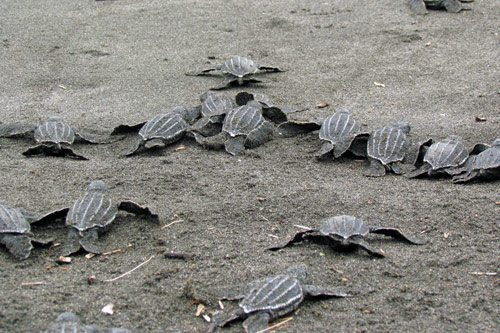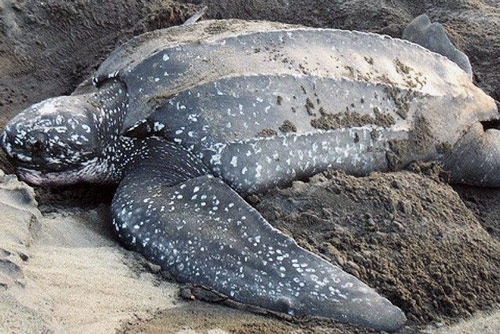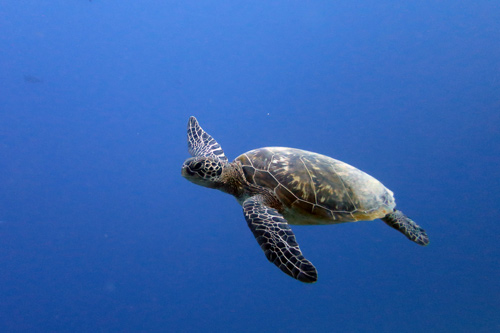The evolution of a remarkable reptile lineage

Turtles are a unique group of vertebrates. Their most striking feature is by far the shell. It is what makes them so easily recognizable as turtles, but how did turtles end up with their shell? This is still an area of great research interest and strongly debated in the scientific community. In this article, we will show you some of the highlights surrounding the research of turtle evolution. Findings from different disciplines, such as the study of fossils, embryonic development and comparative anatomy, allow us to further our understanding of the evolution of this wonderful group.
Learning From Fossils

Fossils are the best indicators we have of what ancient fauna looked like. For a long time, the oldest turtle fossils we knew were dated to about 210 million years old and belonged to the species Proganochelys quenstedtii. This turtle was roughly 70 cm long and lived in the area of today’s Germany, Greenland and Thailand, suggesting it was found all over the ancient continent of Laurasia. The species was first discovered and described in 1887 by German paeleontologist Georg Baur. Proganochelys had a full shell covering the upper and lower part of the body, just like modern turtles do. But how did this shell evolve?


Artistic interpretation ©Nobu Tamura http://spinops.blogspot.com / CC BY/3.0
The riddle remained completely open for debate for more than 120 years, until in 2008 a novel 40 cm fossil was described from China, consisting of a turtle-like reptile which only had half of a shell! The species described as Odontochelys semitestacea, which roughly translates to ‘toothed turtle with half a shell’ had a hard shell on the underside of the body like the plastron of modern turtles, but the upper part, the carapace, was missing. Instead, Odontochelys only had enlarged ribs, indicating that the bottom part of the turtle shell evolved before the top. Since the fossil was found in marine deposits, one hypothesis describes the evolution of the plastron as a defense mechanism against predators coming from beneath in a marine environment. The remarkable fossil of Odontochelys predates Proganochelys by roughly 10 million years, thus moving turtle origins back in time to about 220 million years ago.
The Grandfather Turtle

In 2015, another fossil further improved our knowledge of the connection between turtles and other reptiles. Pappochelys rosinae, the 20 cm ‘grandfather turtle’, is a small reptile with significantly enlarged and flattened ribs. In contrast to the other fossil turtles, Pappochelys did not have a shell and thus most likely represents a transitional form between lizard-like reptiles and turtles, what is colloquially referred to as a ‘missing link’.

in a terrestrial habitat. Artistic interpretation. ©Nobu Tamura (http://spinops.blogspot.ca/) / CC BY-SA
Pappochelys rosinae is similar to other lizards, such as Eunotosaurus africanus, which also had the enlarged and T-shaped ribs, elongated vertebra and generally rather round body shape. Both species were terrestrial animals, which were capable of digging. Eunotosaurus was first speculated to be an ancestor of turtles already in the year 1892! Scientists currently argue that the enlarged ribs are a result of the fossorial lifestyle of both, granting higher stability during digging activity.
It is part of the current consensus that Eunotosaurus already had the typical breathing mechanism of turtles, which is one of the adaptations resulting from a stiffer rib cage. Additionally, the skull of Pappochelys shows certain characteristics typical for other diapsid reptiles, indicating that turtles are indeed closer related to modern lizards and snakes than other extinct groups of reptiles.
Older Than Dinosaurs

Pappochelys dates back to the Triassic period, about 240 million years ago and Eunotosaurus is even older than that (260 mya). Thus, the origin of turtles can be traced back to a time before the magnificent and famous dinosaurs became the dominant vertebrates on land. By the time the infamous Tyrannosaurus rex set foot on what is now North America (68 mya), Proganochelys as one of the first fully shelled turtles, was already extinct again for 140 million years!
The Evolution of Sea Turtles

Now that we know how long ago the general turtle lineage evolved, it leaves the question when did the magnificent sea turtles evolve? Ancestral turtle species lived in various habitats and moved in and out of the water multiple times. In the beginning, these mostly resemble our current day freshwater turtles with limbs adapted to a life in water to varying degrees. All modern sea turtles arose from a common ancestor about 110 million years ago.
For a long time, the oldest known fossil sea turtle was Santanachelys gaffneyi. The fossil was found and described in 1988 in eastern Brazil and dates back to the Early Cretaceous Period. It was a small turtle, roughly 20 cm long with only partially formed flippers. But it had already adapted to life in a marine environment. Santanachelys had large spaces in it’s skull, which are typical for marine turtles. These housed the salt glands, which allow sea turtles with the high salinity of seawater. The shell of Santanachelys already showed the typical incomplete ossification between the ribs, which we can see in modern sea turtles as well. Sea turtle shells are much flatter and less ossified than the often high-domed and sturdy shells of land-dwelling tortoises.
In 2015 researchers from the Senckenberg Research Institute and California State University formally described the species Desmatochelys padillai, a marine turtle that lived in the Lower Cretaceous, so slightly over 120 mya. This oldest cheloniod turtle was over 2 m long and several specimen have been found in Colombia since the 1940 by researchers and hobby paleontologists alike
From Four To Two Sea Turtle Lineages

In total, there were four sea turtle lineages, out of which only two survive until this day: the Cheloniidae and the Dermochelyidae. The extinct families Toxochelyidae and Protostegidae contained some of largest sea turtles ever to swim through our oceans, including the famous Archelon ischyrios.
Archelon was so big, it could even dwarf the biggest extant turtle the leatherback, with a total length of up to 4.6 m! It’s head alone was up to 1 m long and had a large hooked beak. Like modern turtles, Archelon did not have teeth but massive strong jaws. Scientists assume that this turtle foraged on the bottom, pulling invertebrates such as clams from the sand and mud.
At the end of the Cretaceous Period, a devastating asteroid impact on the Yucatan peninsula, or Mexico, vastly changed the global climate. This lead to one of earth’s largest extinction events. It was not only the end of the dinosaurs, but also of protostegid turtles.
Modern Sea Turtles


Currently, there are seven sea turtle species which can be found predominantly in tropical and subtropical waters all around the planet. Out of the seven extant turtle species, six are more closely related to each other than the seventh, the leatherback turtle.
Leatherbacks represent a lineage older than the others and thus have their own family, the Dermochelyidae. They separated from other turtle lineages 100 million years ago, and have evolved a shell specifically adapted to deep diving. The name ‘leatherback’ alludes to this adaptation: in contrast to other sea turtles, leatherbacks do not have a complete hard shell. Their shell consists of a multitude of tiny ossicles embedded in the skin. This leads to a very flexible shell, which is well adapted to the pressure leatherbacks are subjected to when diving to depth greater than 1000 m. Out of several species, only the leatherback Dermochelys coriacea survives until this day, with the last direct sister species falling to extinction roughly two million years ago.

All other modern sea turtles belonging to the family Cheloniidae are hard-shelled marine turtles. Their shell consists of a top and bottom half, the carapace and plastron, which are connected on the side by bony bridges. Bones and a keratinous layer on top build the hardy shell. The pattern of the keratin scutes are typical for different species and help us identify them just like the facial scales allow us to identify individual turtles.
The Future of Sea Turtles
Sea turtles have been in our oceans for millions of years. They are an integral part of the ecosystem and unfortunately highly threatened due to human activity. Rapidly changing environments are an incredible challenge for this ancient group of reptiles. The Olive Ridley Project is working to preserve sea turtles so their success story can continue for many years to come.
References
- Bever GS, Lyson TR, Field DJ and Bhullar BAS 2015. Evolutionary origin of the turtle skull. Nature 525: 239-242.
- Cadena EA and Parham JF 2015. Oldest known marine turtle? A new protostegid from the Lower Cretaceous of Colombia. PaleoBios 31: 1-42.
- Hirayama R 1998. Oldest known sea turtle. Nature 392: 705-708.
- Li C, Wu XC, Rieppel O, Wang, LT and Zhao LJ 2008. An ancestral turtle from the Late Triassic of southwestern China. Nature 456: 497-501.
- Lyson TR, Bever GS, Bhullar BAS, Joyce WG and Gauthier JA 2010. Transitional fossils and the origin of turtles. Biology Letters 6: 830-833.
- Lyson TR, Bever GS, Scheyer TM, Hsiang AY and Gauthier JA 2013. Evolutionary origin of the turtle shell. Current Biology 23: 1113-1119.
- Lyson TR, Schachner ER, Botha-Brink J, Scheyer TM, Lambertz M, Bever GS, Rubidge BS and de Quieroz K 2014. Nature Communications 5: 5211.
- Lyson TR, Rubidge BS, Scheyer TM, de Queiroz K, Schachner ER, Smith RMH, Botha-Brink J and Bever GS 2016. Current Biology 26: 1887-1894.
- Schoch RR and Sues HD 2015. A Middle Triassic stem-turtle and the evolution of the turtle body plan. Nature 523: 584-587.
- Schoch RR, Klein N, Scheyer TM and Sues HD 2019. Microanatomy of the stem-turtle Pappochelys rosinae indicates a predominantly fossorial mode of life and clarifies early steps in the evolution of the shell. Scientific Reports 9: 1-10.
- Spotila JR 2004. Sea Turtles: A complete guide to their biology, behaviour, and conservation. The Johns Hopkins University Press, Baltimore, USA.
- Wieland GR 1896. Archelon ischyros: A new gigantic Cryptodire Testudinate from the Fort Pierre Cretaceous of South Dakota. American Journal of Science 12: 399.

